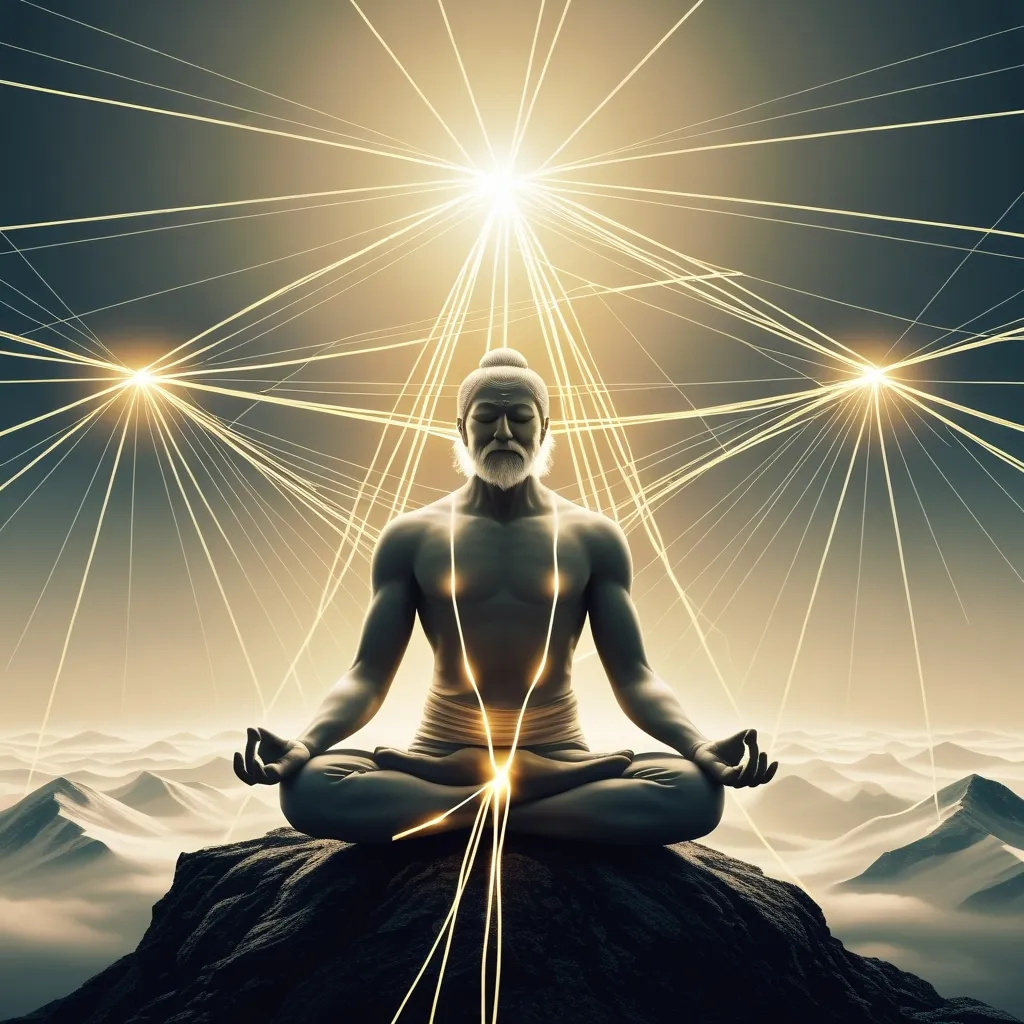Let me try to keep this as simple and as clear as possible, as if I was sharing these thoughts in a quiet corner with you, away from all the fancy words and complicated ideas. We’re talking about something known in Hinduism as “Sthitaprajna.” It’s a big Sanskrit word, but what it’s pointing to is really quite powerful and—dare I say—practical, especially in the messiness of daily life. Imagine, for a moment, having a mind that doesn’t get pushed around by every little up or down, joy or trouble, praise or blame. That’s what Sthitaprajna is all about: being steady, calm, and wise, no matter what’s happening around you.
“To the mind that is still, the whole universe surrenders.” Those words from Lao Tzu, though not from Hinduism, capture the heart of this idea—a mind that is steady sees clearly.
This picture comes straight from the Bhagavad Gita, a classic text from India that people have turned to for centuries when they wanted to figure out how to live without getting constantly thrown off by emotions, desires, and fears. The word Sthitaprajna itself blends two ideas: “sthit” (which means steady, or established), and “prajna” (which means wisdom or clear understanding). When the Gita describes someone with Sthitaprajna, it’s talking about a person whose wisdom is so steady that nothing outside of them can really shake it.
Now, this isn’t about pretending not to have feelings or pushing emotions under the rug. It’s more about knowing who you are so deeply that even when life gets tricky, you don’t lose yourself. Imagine you’re watching a storm from behind a really strong window—you notice the wind, the rain, the noise, but you don’t get swept away by it. This doesn’t mean you become like a robot or lose your humanity. Instead, you’re someone who can feel joy and sadness, hope and discouragement, but none of those become the boss of you.
Let me ask—how often do you find your mood turned upside down because something outside happens? Maybe you get good news at work and feel like a genius, but if criticism comes, your confidence disappears. Or in your relationships, one argument can ruin your day, even though yesterday you were laughing together. Why is it that our sense of well-being swings so wildly? The Gita says it’s because most of us anchor our peace and contentment to things we can’t control. But the Sthitaprajna discovers an inner steadiness that isn’t tangled up with external events.
Here’s something that usually gets missed: this steadiness isn’t dry or lifeless. In fact, people with Sthitaprajna are described as deeply content. They aren’t bored by life—they’re less disturbed by its rollercoaster ride. In the Gita, Krishna says these people act in the world, but not out of pushy desires or the need to prove something. They work, love, help, and create—not because they fear what will happen if they don’t, but simply because it’s the right thing for them to do. As the poet Rumi puts it, “When you do things from your soul, you feel a river moving in you, a joy.”
The journey to this kind of inner steadiness isn’t just about sitting cross-legged and meditating (though that helps). It’s really about seeing clearly what points in your life trip you up and ask, “Is this who I am, or is this just my mind reacting?” Through self-inquiry, or simple but honest curiosity about one’s own thoughts, you begin to spot the difference between passing feelings and your deeper self.
Here’s a twist you may not hear much: Sthitaprajna isn’t only for monks or spiritual teachers. The Gita’s wisdom applies whether you’re a schoolteacher, a parent, a scientist, or someone flipping burgers for a living. Why? Because every one of us has to deal with uncertainty, disappointment, and wild emotion. Just because you’re not chanting in a Himalayan cave doesn’t mean you can’t practice this steadiness. In fact, sometimes the busiest, noisiest places are the best training grounds.
Let’s look at a hidden side: Sthitaprajna involves not just personal calm, but a new outlook on action. Most of us act because we want something—money, approval, love, even spiritual recognition. The Gita suggests acting for its own sake, letting go of what you think will follow. Have you ever noticed how freeing it feels to do something just because it feels right, with no strings attached? That’s part of the secret.
“Muddy water is best cleared by leaving it alone.” These words from Alan Watts shine a light on what happens when we stop trying to control every feeling or outcome. Over time, the mud settles and clarity returns.
There’s something humbling here. Sthitaprajna doesn’t grow by denying struggle, but by facing it without flinching. Every time you don’t act automatically—don’t snap back at criticism, don’t chase every impulse—you’re building a little muscle of inner steadiness. Life becomes less about escaping storms and more about learning to stand quietly in the rain, knowing the weather will change anyway.
Now, you might be wondering: Does anyone actually live like this? The stories of ancient India are full of examples, but the truth is, every time you step back and observe a strong feeling without letting it command you, you taste a small part of Sthitaprajna. For most people, it’s not a one-time switch, but a slow change—like a potter shaping clay a bit each day until a beautiful vessel emerges.
“Between stimulus and response there is a space. In that space is our power to choose our response. In our response lies our growth and our freedom.” So said Viktor Frankl, another wise voice who never heard of Sthitaprajna, but touched the very same secret.
Here’s another angle to consider: Sthitaprajna isn’t about becoming numb or indifferent. Quite the opposite—it helps you experience life more fully, but without being yanked around by every feeling. The joys and sorrows still arrive, but you meet them as a friend might welcome changing weather—sometimes sunny, sometimes stormy, but all part of life’s landscape.
In our world, where social media and news bombard us with reasons to be angry, anxious, or outraged, can you see the value in cultivating this steadiness? The more we react impulsively, the more our peace depends on things we cannot influence. But every moment spent watching carefully and not losing yourself in emotional waves builds a kind of invisible shield.
If you’re feeling overwhelmed by your own moods or by the dramas of daily life, ask yourself, “What would it mean to simply observe this, instead of fighting or denying it?” Over time, this step-back perspective lets emotions pass through without leaving a permanent mark. It’s like watching a scary movie—you can get pulled in, or you can remember, now and then, it’s just images on a screen.
There’s practical advice tucked inside this ancient wisdom. If you make meditation or quiet reflection a part of your day—even a few minutes—it’s like polishing a window so you can see through more clearly. If you practice responding instead of reacting, even in small ways, you’re already on the path.
Let me give you something strange: the person of steady wisdom, according to the Gita, genuinely cares about others, but not because they want thanks or approval. They help because it flows naturally from their understanding of our shared humanity. Isn’t that a simple but powerful shift? If you’re not tied up in your own stories, you become a better listener, friend, and companion.
“The best fighter is never angry.” This old proverb reminds me that steadiness in the face of life is not just about peace, but about strength—a kind of gentle, silent power that can’t be lost.
If all this sounds unreachable, remember: it’s not about never feeling shaken or stressed. Even those with Sthitaprajna are human. The difference is, when trouble arrives, they pause, notice, and allow the feeling to come and go—returning again and again to that steady center. Every time you do the same, you add another brick to your inner foundation.
Can you imagine what daily life would look like if more people tried—even a little—to practice this? Less drama at work, less bitterness at home, fewer arguments flaring out of pride. It’s not idealism. It’s a slow, practical shift that starts from paying attention, breathing, and choosing response over reaction, even once in a while.
Let me end with a kind of invitation. Every time you feel knocked around by life, see if you can pause and take one small step toward inner steadiness: breathe, watch, and notice the space between what happens and how you respond. That’s where wisdom begins—not with big philosophies, but with everyday awareness.
As the Bhagavad Gita says: “Just as a lamp in a windless place does not flicker, so the disciplined mind of a wise person remains steady.”
If you ever wonder whether it’s worth the effort, think of how it might feel to walk through life with that kind of quiet strength. The journey toward Sthitaprajna is not far away. It starts right where you are, with the very next moment you choose to meet life, instead of letting life toss you around.






